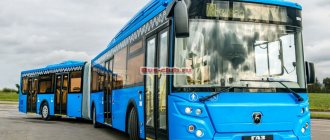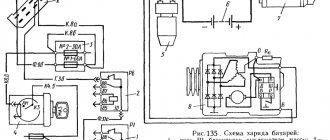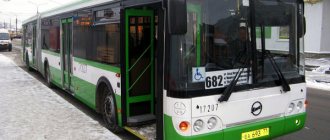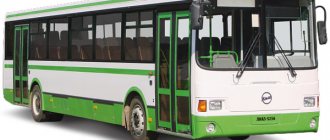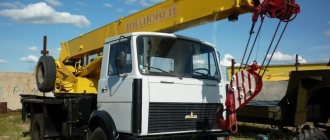Bus LiAZ-429260-79 (ecological class 5, YaMZ-53403 engine. Manual - part 1
Rice. 1.9. Cabin instrument panel
Positions in Fig. 1.9 are marked:
1 — key (non-locking) for unlocking the mechanism for adjusting the position of the steering wheel and the cockpit instrument panel. When you press a button, the pneumatic cylinders of the mechanism bleed air, allowing you to adjust the height and tilt of the steering column for a more comfortable driving position. The function only works when the key is in the first position in the ignition switch and automatically locks the steering column after 5 seconds;
2 - light switch. In the first position, the side lights and workplace lighting are turned on. In the second position, the headlights are turned on (the headlights are switched to low/high beam using the steering column switch). In the third position (pull the switch handle toward you until it clicks), the fog lights turn on. In the fourth position (pull the handle until the second click) the rear fog light turns on;
3 — key for turning on the front cabin heater (single-position, non-fixed). When pressed once, the first speed of the heater is turned on. With subsequent presses, the second/third speed of the heater is turned on; with the fourth press, the heater will turn off. The activation of the front heater is indicated by an indicator on the display of the combined instrument panel;
4 — key (not fixed) for turning on the heated mirrors and cabin windows. After pressing the key, the heating elements are turned on for 5 minutes. During the operation of the heating elements, the corresponding indicator is displayed on the display of the combined instrument;
5 — key to turn on the alarm. The activation of the alarm is indicated by an indicator on the combined instrument panel display;
6 — combined instrument M0KI3 (see Fig. 1.10);
7 - emergency switch. Serves to stop the engine, turn off all power circuits and simultaneously turn on the alarm. See Figure 1.49 for details;
8 — two-position, non-locking “Interior ventilation” key (optional).
Pressing down switches the front fans to supply mode and the rear fans to exhaust mode (automatic mode). Pressing up activates independent selection of the fan and mode (duplicated by the corresponding indicator on the instrument cluster);
9 — key for turning on the interior heaters (two-position, non-locking). When pressed up, the automatic mode of maintaining the set temperature is turned on/off. The interior heaters are controlled using the air conditioning system. The corresponding graphic indicator indicated in Table 1.5, position 46, is activated on the display.
By pressing the down key, manual control of the heaters is activated. Manual mode is only activated if all doors are closed. Pressing down once turns on the first speed of the interior heater fans. When pressed again, the second speed is activated, and when pressed a third time, the heaters are turned off. In accordance with the selected mode, the operation of the heaters is displayed by the indicator on the display of the combined instrument panel, indicated in table 1.5, position 46.
Additional operating mode of interior heater fans “Winter package”
The operating principle is to automatically turn on the maximum speed of the heater fan when the door/doors are opened. The maximum speed is switched on for the heater located next to the open door to create a thermal curtain. On the display of the instrument cluster, the graphic indicator indicated in table 1.5, position 46, is activated.
10 — key for turning on the information system and route indicators (non-locking). When pressed, turns the system on/off. The activation of the system is indicated by the TT23 indicator on the speedometer dial (see Fig. 1.13);
11 — Two-position, non-locking key “Circulation pump and liquid heater”.
By pressing the lower position of the key, the operation of the circulation pump is turned on/off. The indicator light shown in Table 1.2, position TT21, is activated on the instrument cluster.
By pressing the upper position of the key, the operation of the preheater is turned on/off; the TT10 indicator (see Table 1.2) and the graphic indicator on the display (see Table 1.5, item 12) are activated on the instrument cluster.
More detailed information in the section “Control of liquid heater”;
12 — bus air suspension control key — raising/lowering (two-position, non-locking). When you press up, the suspension raises the bus body by 40-50 mm, and when you press the button down, it lowers the body by 40-50 mm. To return the bus to the transport position, press key 16 up. At a speed of more than 15 km/h, the bus will automatically return to the transport position and the functions of changing the air suspension will not be available. More detailed information in the section “Body position control”;
World of Buses 2015
Kolomna, located near Moscow, has become the bus capital of Russia for the eighth time. The World of Buses festival brought together 70 exhibitors from 12 countries. We will tell you in detail about the premieres.
Sparse, but not empty either
The French have a saying: “You don’t have to be a chicken to understand how it feels in a pan.” Even before the opening of the Kolomna festival, it became clear: it will be “thinner” than last year. And there were plenty of clues for this. Firstly, the usual dates were shifted by three weeks - in order to have time to gather as many participants as possible. Secondly, the day before it turned out that major bus brands would not exhibit: Mercedes-Benz, Neoplan, TemSA, Volgabus, Volvo, Hyundai. Thirdly, the representation of Chinese manufacturers of passenger vehicles has thinned out: the list of exhibitors did not include the brands Golden Dragon, Yutong, and Zhongtong. Of the traditional participants in recent years, BAW and Volkswagen Nutzfahrzeuge did not appear on the application list; Imya-M, ST Nizhegorodets, Samotlor-NN, and Sofia did not come.
The festival began with demonstration performances by athletes.
You can understand the depth of the drawdown by comparing it with the results of the previous forum. Last year, more than 120 companies from 19 countries became participants in the VII World of Buses. On the eve of the opening of the VIII festival, the organizers announced the participation of 70. In 2015, there were only 50 of them... A year ago, 80 passenger airliners were exhibited at the exhibition, but in 2015 there were not even the announced 40 buses - in fact, there were half as many of them. And if a couple of years ago there were up to 1,400 visitors in the first two days, then this season there were clearly fewer of them. But still, the pessimistic forecast of skeptics about complete failure did not come true: the festival took place and was full of official events.
Business program
The organizers of the eighth “World of Buses” were the State Unitary Enterprise MO “Mostransavto”, MAP No. 2 “Avtokolonna 1417”. The festival was supported by the Government and the Ministry of Transport of the Moscow Region. By the way, Mostransavto is one of the largest transport companies in Europe: it transports more than 450 million passengers per year. According to the program of the governor of the Moscow region, over 3 billion rubles are allocated annually for the renewal of rolling stock, and this is significant support for passenger transport. The opening of the eighth “World of Buses” was attended by the Minister of Transport of the Moscow Region Alexander Zaitsev, the General Director of the State Unitary Enterprise MO Mostransavto Vadim Sidorenkov, the head of the Kolomna urban district Galina Gracheva, and the head of the Kolomna municipal district Andrey Vaulin. The ceremony was attended by Deputy Chairman of the Moscow Regional Committee of Trade Unions of Motor Transport and Road Workers Yuri Smekalin and Director of MAP No. 2 “Motor Column 1417” Nikolai Sidelev.
The festival included a celebration of the 70th anniversary of Victory in the Great Patriotic War and the 90th anniversary of the beginning of the organization of transport services in the Moscow region. The right to open the “World of Buses 2015” was granted to veterans of the enterprise, participants of the Great Patriotic War: retired army intelligence officer Pyotr Vasilyevich Maltsev and retired sergeant major Nikolai Nikolaevich Pristup, who served in air defense units. As part of the festival, an open competition of professional skills of LiAZ-5292 bus drivers was organized by the State Unitary Enterprise MO Mostransavto. One of the central events was the seminar “Integrated Urban Mobility: How to Solve Transport Problems”, organized by the International Road Transport Union (IRU) together with the Russian Road Transport Union (RAU). Round tables “State regulation of bus transportation: import substitution for transport and tourism” and “Bus service: life cycle from 0 to...” were held at the festival sites.
GAZ Group bets on LiAZ and PAZ
The total number of seats in the comfortable cabin of the Cruise can reach up to 47+1.
The exposition of the Russian Buses division of the GAZ Group became a true decoration of the World of Buses 2015. The open exhibition showcased the promising low-floor mid-class bus LiAZ-4292 for urban transportation, the GolAZ “Cruise” tourist airliner on the Scania platform and the compact PAZ “Vector-3” on an Isuzu chassis for the city and suburbs. Another small class bus, Vector 3, was located in the covered pavilion. Along with the equipment, a special offer was also presented for PAZ buses with the new YaMZ 530 series engine. It is valid from May 1 and, compared to similar models equipped with Cummins engines, provides benefits of up to 175 thousand rubles.
The third “Vector” for the city and suburbs
Painting the body with metallic enamel is an option.
The name “Vector” appeared in the product line of the Pavlovsk Bus Plant in 2011 - the name was assigned to the restyled version of the PAZ-320412 middle-class bus. The 2015 debutant Vector 3 is a representative of the small class, and the three in its index means a three-row layout of the passenger compartment. The declared service life of the semi-supporting car body is 8 years. The resource of the aggregate base is from 700 thousand to 1 million km, which is not bad at all for a vehicle with year-round operation. The body width of less than 2 m (1960 mm) and a minimum turning radius of 7.8 m promotes agility in traffic and facilitates maneuvering at stopping points. The two-door body with a length of 7360 mm and a wheelbase of 3880 mm allows it to carry 33 passengers, including 20 in seats. The door width of 650 mm and the ceiling height of 1920 mm are optimal and do not constrain people when moving around the cabin.
The Isuzu chassis is equipped with a 4-cylinder Japanese Isuzu 4JJ1 Euro 4 engine. The three-liter power unit develops a maximum power of 123 hp. at 2600 rpm. The generated torque with a peak of 354 Nm at 1500 rpm ensures good throttle response, which is especially important in urban transport. As with conventional grooves, the motor here is installed longitudinally in front. It is paired with an Isuzu MYY5T 5-speed manual transmission.
Vector 3 salon.
The use of an imported chassis ensures a balanced life of the body and power line, and promises moderate operating costs for the carrier. Such promises are guaranteed by a service interval of 15 thousand km, low fuel consumption and the availability of spare parts, both by geography and warehouse availability, and by price and delivery time. The estimated cost per kilometer (ownership costs) is 7 rubles/km. The warranty on Vector-3 is 2 years without mileage limitation and 3 years on the automatic transmission.
The ergonomics of the workplace is comparable to the ergonomics of a Japanese classmate.
In the list of options, the manufacturer included an external and internal video surveillance recorder, a digital tachograph (operation without it is generally prohibited), and the GLONASS/GPS satellite system. For an additional fee, fog lights, tinted double-glazed windows, and body paint with metallic enamel are available. The same list includes various options for passenger seats, seat belts, and side panels. Drivers will also appreciate the possibility of additionally installing automatic valves for draining condensate from receivers, air conditioning and audio systems. In a word, Vector-3 enters the market fully armed.
The Vector-3 body, 7360 mm long, is equipped with two doors 650 mm wide.
The third Vector, from the stern, looks completely harmonious.
Low-floor prototype LIAZ-429260
Prototype of a low-floor middle class bus LIAZ-429260 for urban
Quite an unexpected premiere of the “World of Buses 2015” - a low-floor middle-class bus LIAZ-4292 for urban transportation. The declared resource of its load-bearing all-metal body of a carriage layout is 12 years. With 18 standard seats and one seat for transporting a passenger with limited mobility, it is designed to carry 75 people. The overall length of 9.5 m and the wheelbase of 4.5 m allow you to make a turn with a minimum radius of 8.9 m.
The ceiling height in the cabin is variable - from 2.15 to 2.28 m, so any passenger not of Gulliver’s height will feel quite comfortable. This is facilitated by natural ventilation through four vents and two ceiling hatches, as well as forced ventilation with an “August” air conditioner with a capacity of 18 kW. The liquid heating system uses engine heat. In addition, an independent liquid heater Spheros Thermo E-320 is installed. The modern exterior and interior of the promising “city dweller” are designed with the latest technology and meet international requirements for comfort and ergonomics.
Engine compartment
The power line is represented by a 4-cylinder in-line diesel engine YaMZ-534030 Euro-5 with a power of 210 hp. (at 2300 rpm) and a 6-speed automatic transmission ZF 6AP-1000B. The motor develops a maximum torque of 730 Nm in the range of 1300-1600 rpm, which is optimal for transportation at a maximum speed of 65-85 km/h. An independent ZF RL-55 portal axle is installed at the front, and a ZF AV-110 portal axle with a central bevel gear and gear ratio i=5.78 is installed at the rear. The brakes on all wheels are disc, the pneumatic dual-circuit braking system includes ABS and ASR. The aggregate base is represented by a ZF Servocom 8095 steering mechanism with hydraulic booster and a Continental steering column.
Driver's workplace
The specification provides for the use of tires size 265/70 R19.5, fuel tanks with a volume of 180 liters, and a kniling system. The low level of the floor relative to the road ensures quick and convenient boarding and disembarking of citizens. Compared to other models of city airliners, the travel time of this bus along the route is on average 15% less. The body is tilted towards the doors by 7º and a mechanical ramp allows you to move a passenger in a wheelchair. To overcome speed bumps and navigate difficult sections of the route (exits and exits from junctions), an electronic suspension control function is provided. It allows the bus to be raised and lowered at the driver's discretion. The person behind the wheel has access to a video surveillance system, fire extinguishing system, digital tachograph and GLONASS navigation equipment.
In mid-May, this airliner will undergo certification tests, and by the fall it is planned to launch its mass production at the Likinsky Bus Plant. It will use lightweight axles and a gearbox, which made it possible to use a 4-cylinder rather than a 6-cylinder power unit. At the same time, the number of standing places on the 9.5-meter bus compared to the 10.5-meter LIAZ-5292 developed in 2014 has remained virtually unchanged.
Gas NEFAZ and other premieres from Tatarstan
The basic configuration of NEFAZ vehicles uses kniling - a forced body tilt system.
KAMAZ OJSC presented in Kolomna the completely low-floor urban NEFAZ-5299-40-51 with a Euro-5 diesel engine and the gas NEFAZ-52994-40-51 with an updated interior. In addition, the KAMAZ-Marco joint venture demonstrated Bravis in “school” and suburban versions. The frame body of the compressed natural gas bus is welded from metal, galvanized on both sides. This made it possible to provide the passenger car with a factory warranty against through corrosion for a period of 12 years.
In the storage area of the city low-floor area there is a place for wheelchair users.
Design features: rear engine, inward opening doors, electro-pneumatic door control. Combined ventilation through vents and roof hatches. The basic configuration uses kniling - a forced body tilt system. It increases the convenience of boarding and disembarking and reduces the time spent at stops. Depending on the version, with 25 seats, the total passenger capacity reaches 105 or 116 people. The floor height at the front and rear is 340 mm. The width of the door passage reaches 1200 mm, the distance from floor to ceiling is 2545 mm.
The driver's seat of the low-floor city bus NEFAZ-52994-40-51, powered by methane.
A 6-cylinder in-line diesel Mercedes-Benz OM 906 LAG/EEV (Euro-5) with a displacement of 6.9 liters and a power of 279 hp is installed in the engine shaft. and a maximum torque of 1000 Nm. The volume of natural gas supplied under pressure is 200 atm. in eight cylinders with a volume of 984 l (123 l each) it reaches 197 m3. The cruising range on one refueling ranges from 400 to 500 km.
The KAMAZ-Marco joint venture demonstrated Bravis in a “school” version.
The suburban Marcopolo Bravis with a gross weight of 9500 kg with 20-26 seats is capable of carrying 42-50 passengers.
"NEMAN", manufactured... at MZKT
The “face” of the Belarusian “Neman” cannot be confused with another “portrait” even if one wants to.
Recently, the Minsk Wheel Tractor Plant has begun assembling passenger vehicles, in other words, buses. It is not surprising that the VOLAT trademark now appears next to the NEMAN logo. In Kolomna, this equipment was presented by NEMAN Bass RUS LLC, the official distributor in Russia. The buses are sold through the IVECO service network, which is not surprising: the body is mounted on the chassis of the medium-duty model Daily 65C15 (4x2). As part of the festival, the suburban “Neman-420224-11” was presented to the transport community in absentia at a cost of 3.73 million rubles. with VAT, and in person - “Tourist” worth 4.1 million rubles.
Front panel with safety steering column and power steering.
The welded body of the exhibition sample is lined with: the roof and side panels with galvanized steel, the front and rear parts of the body with fiberglass panels, aluminum service hatches and tinted glass units with silk-screen coating. The comfortable interior is equipped with adjustable high-back seats installed in pairs on the left and right in the direction of travel. Airplane-type luggage racks are installed above them. On the sides and in the stern there are small luggage compartments with a total capacity of 1.9 m3. God knows how much volume, but for corporate transportation (which is how sellers position it in the first place) it is quite enough.
On the back of each chair there are handles, a folding table and a mesh pocket.
There is no point in listing the advantages of the Italian chassis: they are obvious. But it’s not superfluous to clarify some parameters. The loaded weight of the “Belarusian” is 4650 kg, the total weight is 7000 kg. For overall dimensions 8040x2340x3000 mm, very decent characteristics. With a wheelbase of 4350 mm, the turning radius should be comparable to its classmates, but you need to get used to the overhangs of the body. If the front one of 1010 mm is very comfortable for the driver, the rear one of 2630 mm requires increased attention when maneuvering. The front independent torsion bar suspension and rear air springs provide decent driving comfort. The dynamics are driven by a 4-cylinder, three-liter IVECO F1C Euro-4 diesel engine with a power of 146 hp, to which a mechanical six-speed IVECO 6S 2840 OD is mated.
Open luggage racks are located above the adjustable Neman seats with high backs.
The consumer properties of the suburban "Neman" can be enhanced by the available options: roof-mounted Turkish Yilkar air conditioning unit with a power of 15 kW with air supply for each passenger, Prology DVD audio-video system, installation of two additional seats (a guide's place at the entrance and a fifth chair in the last row). Manufacturer's warranty: 12 months for the bus as a whole and 24 months or 200 thousand km for the power line (engine, gearbox, rear axle).
Russian ambitions of MAZ
MAZ-232062 with a capacity of 35 passengers was created for intercity transportation.
By tradition, the bus branch of the Minsk Automobile Plant was represented by AvtoMAZ Vostok OJSC, the official dealer for the sale of passenger vehicles in Russia. Businessmen brought three cars to Kolomna, two of which were new for the season. This is the MAZ-232062 for intercity transportation, as well as the city MAZ-103965 with a compressed natural gas (methane) engine.
The intercity MAZ-232062 is essentially identical to the suburban model MAZ-232162. The differences lie in the size of the second door located in the wheelbase (it is wider on the “suburb”) and the number of seats (the “suburb” has two fewer seats, but the total capacity reaches 50 passengers versus 35 on the “intercity”). The debutant's luggage compartments reach a volume of 2.8 m3, while in the earlier version they are 0.6 m3 smaller. The rest of the characteristics are like a carbon copy. Overall dimensions of 9165/2550/3300 mm and a wheelbase of 4560 mm are reflected in the turning radius - it is 10.5 m. The body is mounted on an air suspension: two-point front and four-point rear. The total weight in both cases is 13800 kg. At the same time, a fully loaded bus can maintain a maximum speed of 85 km/h. Such dynamics of the “zero sixty-two” are provided by the Mercedes-Benz OM 924 LA engine with a power of 218 hp. and ZF 6S 1010BO transmission.
The premiere of the World of Buses 2015 is an 11.9-meter MAZ-103965 with a methane engine.
The second debutant of the World of Buses, MAZ-103965 is more likely designed for large cities. With a length of 11,895 mm, a width of 2,048 mm, a height of 3,400 mm and a wheelbase of 6,140 mm, it is capable of carrying more than 100 passengers, including 22 in seating positions. The outer turning radius is no more than 11.3 m. Ground clearance when fully loaded is no less than 180 mm, the height of the step above the road level is 340 mm in the transport position and 270 mm when using the kneeling function. Engine Mercedes-Benz OM 906 LAG EEV Euro-5 with 279 hp. and an automatic 6-speed Allison T310 W/Ret transmission, depending on the bus configuration, allows a maximum speed of 77-105 km/h. The total volume of gas cylinders reaches 276 liters, however, nothing is reported about the mileage on them. Nevertheless, MAZ's gas incarnation expands its sales horizons in Russia: transport operators are increasingly choosing airliners with methane-powered engines.
Higer 6122B: we’ve already seen this somewhere...
Russia presented its first tourist airliner, Higer 6122B.
Dreamscape presented Russia's first tourist liner Higer 6122B. The newly-made “Chinese” covered thousands of kilometers under its own power without a single breakdown. According to the company's top managers, four such buses have already been imported into the Russian Federation and there is even a pre-order for 45 cars. At the same time, the cost of a new “tourist” is rather high - from 9.5 million rubles. in view of VAT. True, critical arrows have already been fired at the newly minted representative of the Chinese auto industry - the exterior design looks too much like the stylistic decision of the Neoplan Starliner (which was publicly stated at the press conference).
Aluminum luggage compartment hatch covers Higer 6122B with vertical sliding opening.
The twelve-meter airliner has a six-meter wheelbase, a 390-liter fuel tank and an average diesel fuel consumption of 25 l/100 km. AdBlue consumption is 5% of fuel consumption, and the transportable reserve in a standard tank is 35 liters. With a curb weight of 13980-14180 kg, the total mass of the “tourist” reaches 18000-18540 kg. It can be moved by a 340-horsepower 6-cylinder in-line diesel engine Cummins ISL340.50 of Euro-5 standard. It develops a maximum torque of 1482 Nm at 1400 rpm and is integrated in the power line with a manual transmission made in China by Qijiang Gear Transmission. A licensed ZF transmission can be supplied to order.
The luxury salon can be equipped according to the scheme 49+1+1 or 51+1+1.
The developers have provided three options for seating arrangements with a number of seats of 47, 49 or 51, plus a driver and guide seat. The list of available equipment includes an audio-video system with two LCD monitors, a dry closet, a refrigerator, a device for heating and cooling water, an air conditioner, and a tachograph. There is a driver's berth, cruise control, GLONASS satellite system, G-Bos. Thanks to the cataphoresis treatment of the body, the manufacturer provides a 10-year guarantee against through corrosion. It is noted that a thicker layer of insulating foam is used to insulate the interior, and the interior finishing materials are resistant to wear and low temperatures. There are 11 stoves and one separate water heater installed inside. And if we discard the analogy with Neoplan, the product turned out to be worthy.
The driver's area of the Higer 6122B is equipped according to international standards.
In the stern of the Higer 6122B, a 6-cylinder in-line Cummins ISL 340.50 Euro 5 engine is installed longitudinally.
Irisbus, MAN, Scania, FoxBus and others
FoxBus is produced in a “tourist” version with a capacity of 26 to 31 passengers and a “suburban” version with a seat configuration from 19+17 to 29+6.
Innovative Technologies LLC from the city of Vorsma presented a new generation bus FoxBus, which is produced in a “tourist” version with a capacity of 26 to 31 passengers (8 cabin layout options) and a “suburb” with nine seating arrangements with a layout from 19+17 to 29+6. We visited the production of this bus last year; it is an interesting model with an interesting history of creation. Link to material: FoxBus: Made in Russia
The aisle between the FoxBus seats is not very wide, but not too narrow either.
The IVECO Crossway LE City city bus has a capacity of 31+84+1 passengers.
There was little news from the other participants of World of Buses 2015, but nevertheless, importers and Russian manufacturers brought their equipment to Kolomna. For example, Irisbus showed three passenger vehicles, of which the emphasis was on the IVECO Crossway LE City city bus with a capacity of 31+84+1 passengers.
There is a warning regarding the freshly painted body of the Italian airliner.
At the stand of MAN Truck and Bus RUS LLC, the MAN Lion's Coach (R07) tourist liner with a MAN D 2066 LOH 07 engine with a power of 400 hp shone with its varnished sides. and intercity MAN Lion's Regio (R12) with a 310-horsepower MAN D 2066 LUH 22 engine, both Euro-4 standards. A special feature of the latter bus is the wheelchair lift located at the second door.
In the year of the 100th anniversary of the production of commercial vehicles, MAN showed the time-tested Lion's Coach.
The well-known Scania Higer A80 was presented at the Scania exposition. It is produced both in an intercity version with a cabin for 51 seats (4x2) or 59 seats (6x2*4), and as a “tourist” with 47 or 49 seats in a two-axle version and 57 seats in a three-axle version.
The Scania exposition featured the well-known Scania Higer A80 with a 6x2*4 wheel arrangement.
Corporate transport: 20-seater IVECO Daily 50C15V bus from Nizhny Novgorod.
A whole scattering of small class buses was presented from Nizhny Novgorod. In particular, a 20-seat corporate “cab driver” based on IVECO Daily 50C15V with dimensions of 7012x1996x2750 mm with a wheelbase of 3950 mm and an engine power of 146 hp was exhibited. The cost of the exhibition sample was set at 2.289 million rubles.
The interior of the IVECO Daily 50C15V is decorated in soft peach tones.
A converted tourist Mercedes-Benz Sprinter 515 CDI with 20 seats costs 2.749 million rubles.
Displayed in the same row as it was a 20-seater “tourist” on the platform of a rear-wheel drive Mercedes-Benz Sprinter 515 CDI with dimensions 7345x1993x2800 mm, costing 2.749 million rubles. A school bus based on the front-wheel drive 130-horsepower FIAT Ducato was also shown here. With a length of 6363 mm, a width of 2050 mm, a height of 2524 mm and a wheelbase of 4035 mm, the number of passenger seats is 20+2+1. The price of the exhibition sample is set at 2.145 million rubles.
GAZelle NEXT, converted into a bus for transporting schoolchildren. An additional step makes entering and exiting the cabin easier.
Commercial Vehicles LLC of the GAZ Group rolled out for public viewing the GAZelle NEXT A67R42 school bus with a capacity of 21+1+1 and the city version of the GAZelle NEXT A64R42 with an 18+1+1 interior layout. The third exhibit of the division was a “tourist” on the GAZelle NEXT A60R42 platform with a landing formula of 15+0+1.
Tourist bus GAZ A60R42 “GAZelle NEXT” with 15 seats.
Among the few Chinese vehicles were King Long gas buses.
That, in fact, is the entire “World of Buses”, not counting two Mercedes-Benz trucks: an Actros tow truck and an onboard Zetros with a CMU, as well as an old Setra 315, turned into a shooting range.
Text and photo: Alexander Trokhachev
